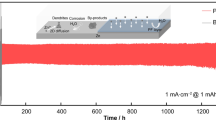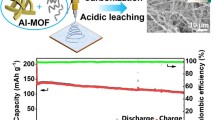Abstract
Zinc-ion batteries (ZIBs) are desirable as one of the most potential energy storage devices owing to the environmental friendliness and abundant zinc reserves. Nevertheless, numerous promising cathode materials suffer from complicated preparation processes and low electronic conductivity. Herein, a high-performance cathode material (HNTs-PPy) for ZIBs based on halloysite nanotubes (HNTs) with a polypyrrole (PPy) coating is prepared through an efficient one-step in situ polymerization. The PPy nanoparticles can be uniformly and densely coated on the external surface of HNTs with a thickness of ~ 3.8 nm. The surface valence state and banding configuration of HNTs-PPy show the diffusion of the electron cloud from the outside of the PPy to the inside of HNTs and further form a strong polycomplexation between HNTs and PPy. Compared to PPy, introducing HNTs efficiently increases the contact area between the electrolyte and the composite cathode materials and sequentially enhances the cycling stability. The ZIBs based on HNTs-PPy cathode also achieve a capacity retention of 87.4% at a current density of 0.5 A g−1 after 500 cycles. This work develops a new perspective strategy for large-scale production of time- and cost-efficient cathode materials for aqueous batteries.





Similar content being viewed by others
References
Song M, Tan H, Chao D, Fan HJ (2018) Recent advances in Zn-ion batteries. Adv Func Mater 28(41):1802564. https://doi.org/10.1002/adfm.201802564
Xu W, Wang Y (2019) Recent progress on zinc-ion rechargeable batteries. Nanomicro Lett 11(1):90. https://doi.org/10.1007/s40820-019-0322-9
Xu P, Wang C, Zhao B, Zhou Y, Cheng H (2021) An interfacial coating with high corrosion resistance based on halloysite nanotubes for anode protection of zinc-ion batteries. J Colloid Interface Sci 602:859–867. https://doi.org/10.1016/j.jcis.2021.06.057
Xu P, Wang C, Zhao B, Zhou Y, Cheng H (2021) A high-strength and ultra-stable halloysite nanotubes-crosslinked polyacrylamide hydrogel electrolyte for flexible zinc-ion batteries. J Power Sources 506:230196. https://doi.org/10.1016/j.jpowsour.2021.230196
Deng C, Xie X, Han J, Tang Y, Gao J, Liu C, Shi X, Zhou J, Liang S (2020) A sieve-functional and uniform-porous kaolin layer toward stable zinc metal anode. Adv Func Mater 30(21):2000599. https://doi.org/10.1002/adfm.202000599
Wan F, Niu Z (2019) Design strategies for vanadium-based aqueous Zinc-Ion batteries. Angew Chem Int Ed Engl 58(46):16358–16367. https://doi.org/10.1002/anie.201903941
Wang N, Zhai S, Ma Y, Tan X, Jiang K, Zhong W, Zhang W, Chen N, Chen W, Li S, Han G, Li Z (2021) Tridentate citrate chelation towards stable fiber zinc-polypyrrole battery with hybrid mechanism. Energy Storage Mater 43:585–594. https://doi.org/10.1016/j.ensm.2021.10.004
Fu Y, Wei Q, Zhang G, Wang X, Zhang J, Hu Y, Wang D, Zuin L, Zhou T, Wu Y, Sun S (2018) High-Performance Reversible Aqueous Zn-Ion Battery Based on Porous MnOx Nanorods Coated by MOF-Derived N-Doped Carbon. Adv Energy Mater 8(26):1801445. https://doi.org/10.1002/aenm.201801445
Jiao Y, Kang L, Berry-Gair J, McColl K, Li J, Dong H, Jiang H, Wang R, Corà F, Brett DJL, He G, Parkin IP (2020) Enabling stable MnO2 matrix for aqueous zinc-ion battery cathodes. J Mater Chem A 8(42):22075–22082. https://doi.org/10.1039/d0ta08638j
Alfaruqi MH, Mathew V, Gim J, Kim S, Song J, Baboo JP, Choi SH, Kim J (2015) Electrochemically induced structural transformation in a γ-MnO2 cathode of a high capacity zinc-ion battery system. Chem Mater 27(10):3609–3620. https://doi.org/10.1021/cm504717p
Xu C, Li B, Du H, Kang F (2012) Energetic zinc ion chemistry: the rechargeable zinc ion battery. Angew Chem Int Ed Engl 51(4):933–935. https://doi.org/10.1002/anie.201106307
Xu C, Du H, Li B, Kang F, Zeng Y (2009) Reversible insertion properties of Zinc ion into manganese dioxide and its application for energy storage. Electrochem Solid-State Lett 12(4):A61. https://doi.org/10.1149/1.3065967
Sun W, Wang F, Hou S, Yang C, Fan X, Ma Z, Gao T, Han F, Hu R, Zhu M, Wang C (2017) Zn/MnO2 battery chemistry With H(+) and Zn(2+) coinsertion. J Am Chem Soc 139(29):9775–9778. https://doi.org/10.1021/jacs.7b04471
Knight JC, Therese S, Manthiram A (2015) Chemical extraction of Zn from ZnMn2O4-based spinels. J Mater Chem A 3(42):21077–21082. https://doi.org/10.1039/c5ta06482a
Zhang N, Dong Y, Jia M, Bian X, Wang Y, Qiu M, Xu J, Liu Y, Jiao L, Cheng F (2018) Rechargeable aqueous Zn–V2O5 battery with high energy density and long cycle life. ACS Energy Lett 3(6):1366–1372. https://doi.org/10.1021/acsenergylett.8b00565
Kundu D, Adams BD, Duffort V, Vajargah SH, Nazar LF (2016) A high-capacity and long-life aqueous rechargeable zinc battery using a metal oxide intercalation cathode. Nat Energy. https://doi.org/10.1038/nenergy.2016.119
Ding J, Du Z, Gu L, Li B, Wang L, Wang S, Gong Y, Yang S (2018) Ultrafast Zn(2+) intercalation and deintercalation in vanadium dioxide. Adv Mater 30(26):e1800762. https://doi.org/10.1002/adma.201800762
Lai J, Zhu H, Zhu X, Koritala H, Wang Y (2019) Interlayer-expanded V6O13·nH2O architecture constructed for an advanced rechargeable aqueous zinc-ion battery. ACS Appl Energy Mater 2(3):1988–1996. https://doi.org/10.1021/acsaem.8b02054
Shin J, Choi DS, Lee HJ, Jung Y, Choi JW (2019) Hydrated intercalation for high-performance aqueous zinc ion batteries. Adv Energy Mater 9(14):1900083. https://doi.org/10.1002/aenm.201900083
Wan F, Zhang L, Dai X, Wang X, Niu Z, Chen J (2018) Aqueous rechargeable zinc/sodium vanadate batteries with enhanced performance from simultaneous insertion of dual carriers. Nat Commun 9(1):1656. https://doi.org/10.1038/s41467-018-04060-8
He P, Zhang G, Liao X, Yan M, Xu X, An Q, Liu J, Mai L (2018) Sodium ion stabilized vanadium oxide nanowire cathode for high-performance zinc-ion batteries. Adv Energy Mater 8(10):1702463. https://doi.org/10.1002/aenm.201702463
Yang Y, Tang Y, Fang G, Shan L, Guo J, Zhang W, Wang C, Wang L, Zhou J, Liang S (2018) Li+ intercalated V2O5·nH2O with enlarged layer spacing and fast ion diffusion as an aqueous zinc-ion battery cathode. Energy Environ Sci 11(11):3157–3162. https://doi.org/10.1039/c8ee01651h
Trocoli R, La Mantia F (2015) An aqueous zinc-ion battery based on copper hexacyanoferrate. Chemsuschem 8(3):481–485. https://doi.org/10.1002/cssc.201403143
Jia Z, Wang B, Wang Y (2015) Copper hexacyanoferrate with a well-defined open framework as a positive electrode for aqueous zinc ion batteries. Mater Chem Phys 149–150:601–606. https://doi.org/10.1016/j.matchemphys.2014.11.014
Kasiri G, Trócoli R, Bani Hashemi A, La Mantia F (2016) An electrochemical investigation of the aging of copper hexacyanoferrate during the operation in zinc-ion batteries. Electrochim Acta 222:74–83. https://doi.org/10.1016/j.electacta.2016.10.155
Zhang L, Chen L, Zhou X, Liu Z (2015) Towards high-voltage aqueous metal-ion batteries beyond 1.5 V: the zinc/zinc hexacyanoferrate system. Adv Energy Mater 5(2):1400930. https://doi.org/10.1002/aenm.201400930
Xu W, Zhao K, Wang Y (2018) Electrochemical activated MoO2/Mo2N heterostructured nanobelts as superior zinc rechargeable battery cathode. Energy Storage Mater 15:374–379. https://doi.org/10.1016/j.ensm.2018.06.028
Li G, Yang Z, Jiang Y, Zhang W, Huang Y (2016) Hybrid aqueous battery based on Na3V2(PO4)3/C cathode and zinc anode for potential large-scale energy storage. J Power Sources 308:52–57. https://doi.org/10.1016/j.jpowsour.2016.01.058
Li W, Wang K, Cheng S, Jiang K (2018) A long-life aqueous Zn-ion battery based on Na3V2(PO4)2F3 cathode. Energy Storage Mater 15:14–21. https://doi.org/10.1016/j.ensm.2018.03.003
Xie C, Zhang H, Xu W, Wang W, Li X (2018) A long cycle life, self-healing zinc-iodine flow battery with high power density. Angew Chem Int Ed Engl 57(35):11171–11176. https://doi.org/10.1002/anie.201803122
Li B, Nie Z, Vijayakumar M, Li G, Liu J, Sprenkle V, Wang W (2015) Ambipolar zinc-polyiodide electrolyte for a high-energy density aqueous redox flow battery. Nat Commun 6:6303. https://doi.org/10.1038/ncomms7303
Lahiri A, Yang L, Li G, Endres F (2019) Mechanism of Zn-ion intercalation/deintercalation in a Zn-polypyrrole secondary battery in aqueous and bio-ionic liquid electrolytes. ACS Appl Mater Interfaces 11(48):45098–45107. https://doi.org/10.1021/acsami.9b15340
Yu H, Liu G, Wang M, Ren R, Shim G, Kim JY, Tran MX, Byun D, Lee JK (2020) Plasma-assisted surface modification on the electrode interface for flexible fiber-shaped Zn-polyaniline batteries. ACS Appl Mater Interfaces 12(5):5820–5830. https://doi.org/10.1021/acsami.9b19172
Huang J, Wang Z, Hou M, Dong X, Liu Y, Wang Y, Xia Y (2018) Polyaniline-intercalated manganese dioxide nanolayers as a high-performance cathode material for an aqueous zinc-ion battery. Nat Commun 9(1):2906. https://doi.org/10.1038/s41467-018-04949-4
Ng CH, Lim HN, Lim YS, Chee WK, Huang NM (2015) Fabrication of flexible polypyrrole/graphene oxide/manganese oxide supercapacitor. Int J Energy Res 39(3):344–355. https://doi.org/10.1002/er.3247
Cao L, Zhang B, Ou X, Wang C, Peng C, Zhang J (2019) Synergistical coupling interconnected ZnS/SnS2 nanoboxes with polypyrrole-derived n/s dual-doped carbon for boosting high-performance sodium storage. Small 15(9):e1804861. https://doi.org/10.1002/smll.201804861
Zhou M, Xiong Y, Cao Y, Ai X, Yang H (2013) Electroactive organic anion-doped polypyrrole as a low cost and renewable cathode for sodium-ion batteries. J Polym Sci Part B Polym Phys 51(2):114–118. https://doi.org/10.1002/polb.23184
Killian JG, Coffe BM, Gao F, Poehler TO, Searson PC (1996) Polypyrrole composite electrodes in an all-polymer battery system. J Electrochem Soc 143(3):936–942
Li X, Xie X, Lv R, Na B, Wang B, He Y (2019) Nanostructured polypyrrole composite aerogels for a rechargeable flexible aqueous Zn-ion battery with high rate capabilities. Energ Technol 7(5):1801092. https://doi.org/10.1002/ente.201801092
Yah WO, Xu H, Soejima H, Ma W, Lvov Y, Takahara A (2012) Biomimetic dopamine derivative for selective polymer modification of halloysite nanotube lumen. J Am Chem Soc 134(29):12134–12137. https://doi.org/10.1021/ja303340f
Cavallaro G, Milioto S, Lazzara G (2020) Halloysite nanotubes: interfacial properties and applications in cultural heritage. Langmuir 36(14):3677–3689. https://doi.org/10.1021/acs.langmuir.0c00573
Panchal A, Fakhrullina G, Fakhrullin R, Lvov Y (2018) Self-assembly of clay nanotubes on hair surface for medical and cosmetic formulations. Nanoscale 10(38):18205–18216. https://doi.org/10.1039/c8nr05949g
Yuan P, Tan D, Annabi-Bergaya F (2015) Properties and applications of halloysite nanotubes: recent research advances and future prospects. Appl Clay Sci 112–113:75–93. https://doi.org/10.1016/j.clay.2015.05.001
Rouhi M, Babamoradi M, Hajizadeh Z, Maleki A, Maleki ST (2020) Design and performance of polypyrrole/halloysite nanotubes/Fe3O4/Ag/Co nanocomposite for photocatalytic degradation of methylene blue under visible light irradiation. Optik 212:164721. https://doi.org/10.1016/j.ijleo.2020.164721
Du C, Zhang Y, Zhang D, Zhang B, Zhao W (2021) An in situ polymerized polypyrrole/halloysite nanotube–silver nanoflower based flexible wearable pressure sensor with a large measurement range and high sensitivity. J Mater Chem C 9(38):13172–13181. https://doi.org/10.1039/d1tc03135j
Yang C, Liu P, Zhao Y (2010) Preparation and characterization of coaxial halloysite/polypyrrole tubular nanocomposites for electrochemical energy storage. Electrochim Acta 55(22):6857–6864. https://doi.org/10.1016/j.electacta.2010.05.080
Lazzara G, Cavallaro G, Panchal A, Fakhrullin R, Stavitskaya A, Vinokurov V, Lvov Y (2018) An assembly of organic-inorganic composites using halloysite clay nanotubes. Curr Opin Colloid Interface Sci 35:42–50. https://doi.org/10.1016/j.cocis.2018.01.002
Derjaguin B, Landau L (1993) Theory of the stability of strongly charged lyophobic sols and of the adhesion of strongly charged particles in solutions of electrolytes. Progr Surf Sci 43(1–4):30–59
Cavallaro G, Milioto S, Konnova SA, Fakhrullina G, Lvov Y (2020) Halloysite/keratin nanocomposite for human hair photoprotection coating. ACS Appl Mater Interfaces 12(21):24348–24362
Zhang D, Wu Z, Zong X, Zhang Y (2018) Fabrication of polypyrrole/Zn2SnO4 nanofilm for ultra-highly sensitive ammonia sensing application. Sens Actuators B Chem 274:575–586. https://doi.org/10.1016/j.snb.2018.08.001
Hong J, Wu T, Wu H, Zeng B, Zeng S, Chen T, Wang X, Lu Z, Yuan C, Balaji K, Petri DFS, Dai L (2021) Nanohybrid silver nanoparticles@halloysite nanotubes coated with polyphosphazene for effectively enhancing the fire safety of epoxy resin. Chem Eng J 407:127087. https://doi.org/10.1016/j.cej.2020.127087
Cheng H, Liu Q, Yang J, Zhang J, Frost RL, Du X (2011) Infrared spectroscopic study of halloysite-potassium acetate intercalation complex. J Mol Struct 990(1–3):21–25. https://doi.org/10.1016/j.molstruc.2011.01.008
Yang X, Zhang Y, Zheng D, Yue J, Liu M (2020) Nano-biocomposite films fabricated from cellulose fibers and halloysite nanotubes. Appl Clay Sci 190:105565. https://doi.org/10.1016/j.clay.2020.105565
Rudge A, Davey J, Raistrick I, Gottesfeld S, Ferraris JP (1994) Conducting polymers as active materials in electrochemical capacitors. J Power Sources 47(1–2):89–107
Acknowledgements
The authors acknowledge the National Natural Science Foundation of China (42102033, 42172043), the support from the Fundamental Research Funds for the Central Universities (2652019032), the support from the Science and Technology Major Projects of Shanxi Province of China (20181101003), and the Inner Mongolia Science and Technology Plan (2022YFHH0050).
Author information
Authors and Affiliations
Corresponding authors
Ethics declarations
Conflict of interest
The authors declare no conflict of interest.
Additional information
Publisher's Note
Springer Nature remains neutral with regard to jurisdictional claims in published maps and institutional affiliations.
Rights and permissions
Springer Nature or its licensor (e.g. a society or other partner) holds exclusive rights to this article under a publishing agreement with the author(s) or other rightsholder(s); author self-archiving of the accepted manuscript version of this article is solely governed by the terms of such publishing agreement and applicable law.
About this article
Cite this article
Xu, P., Zhou, Y., Wang, C. et al. Conductive halloysite nanotubes/polypyrrole cathodes prepared by one-step in situ polymerization for zinc-ion batteries. Polym. Bull. 81, 1117–1129 (2024). https://doi.org/10.1007/s00289-023-04730-8
Received:
Revised:
Accepted:
Published:
Issue Date:
DOI: https://doi.org/10.1007/s00289-023-04730-8




